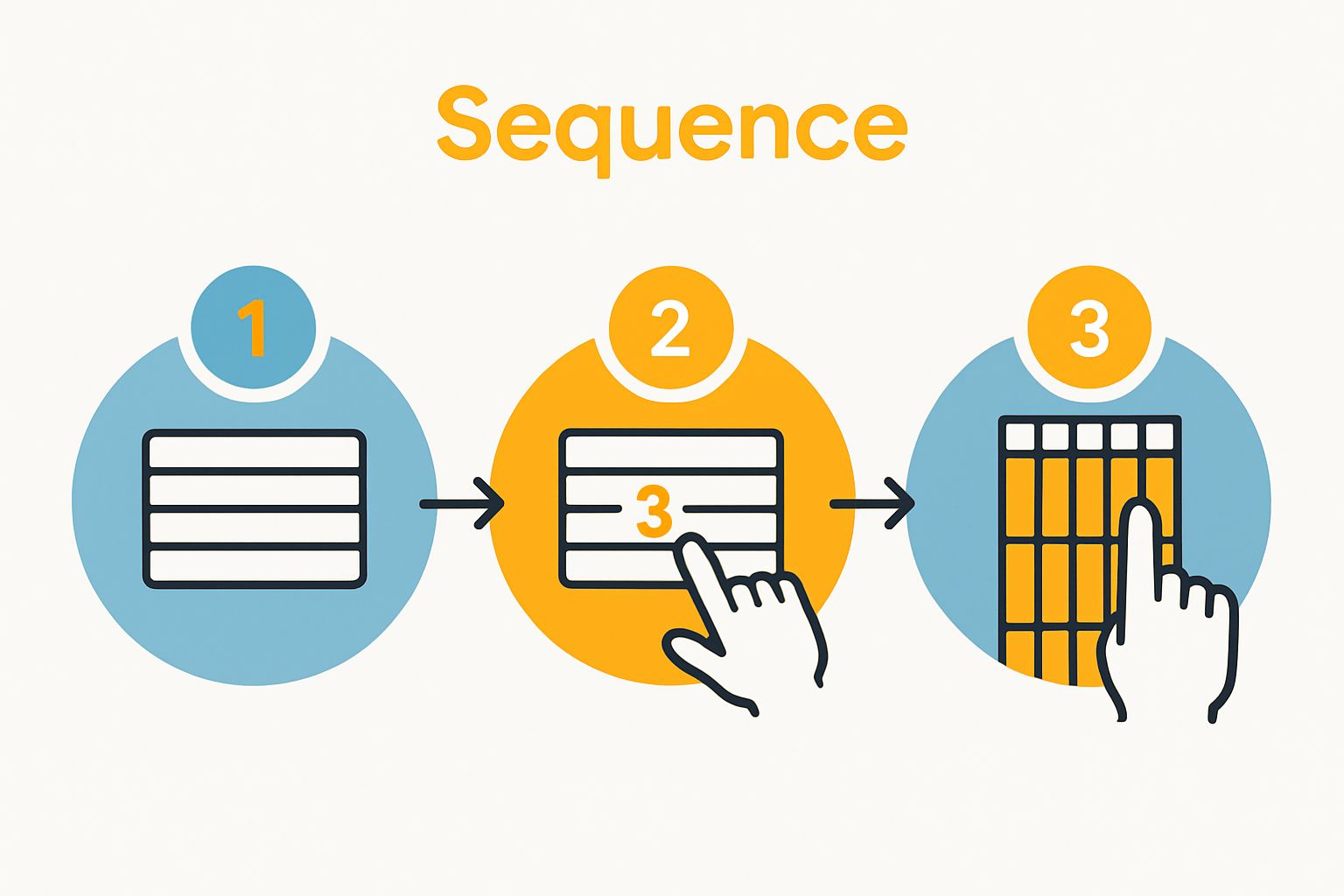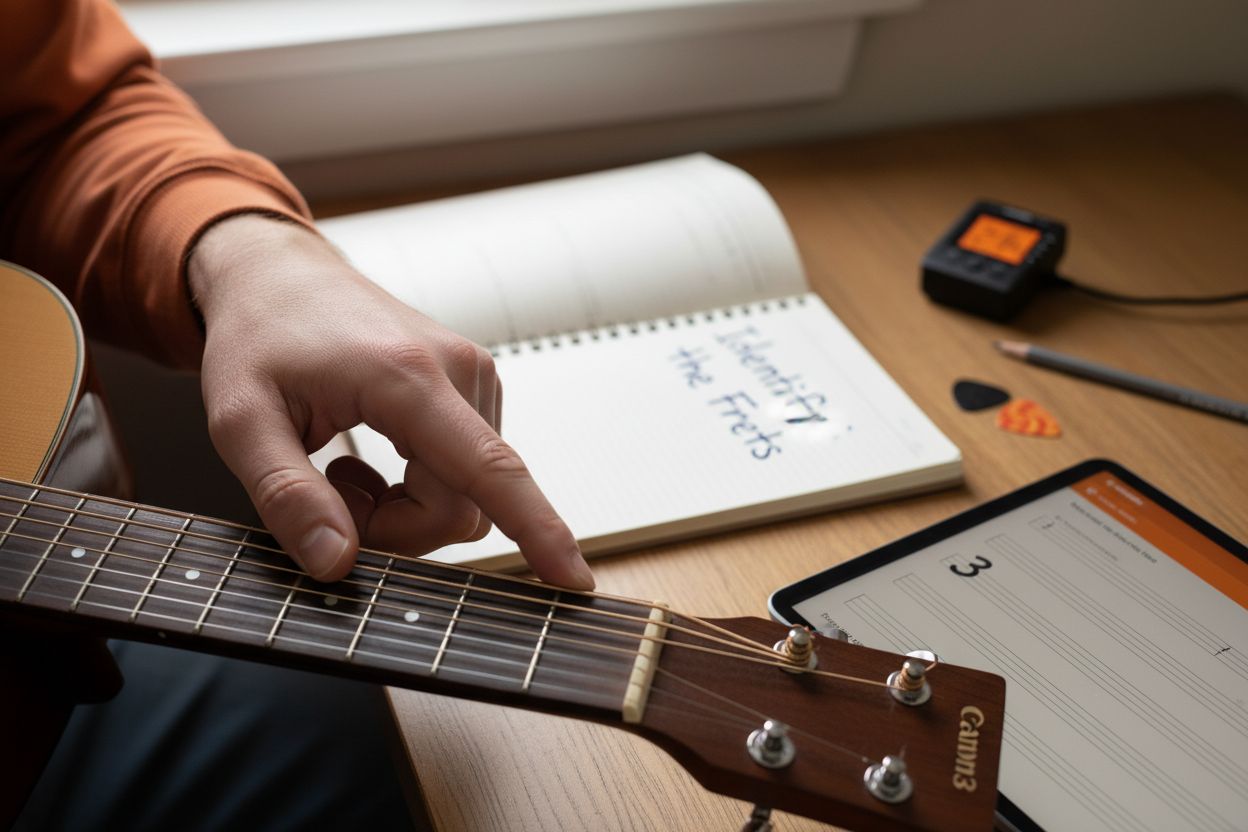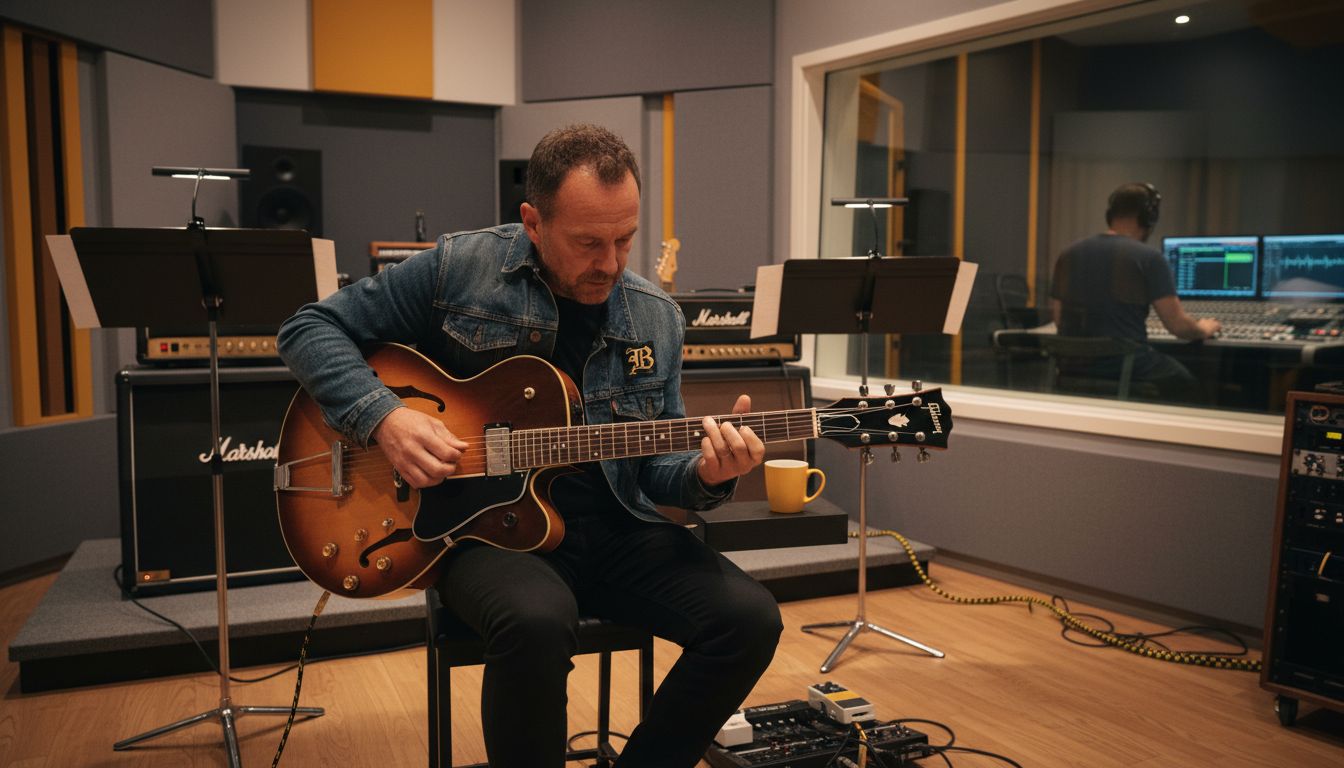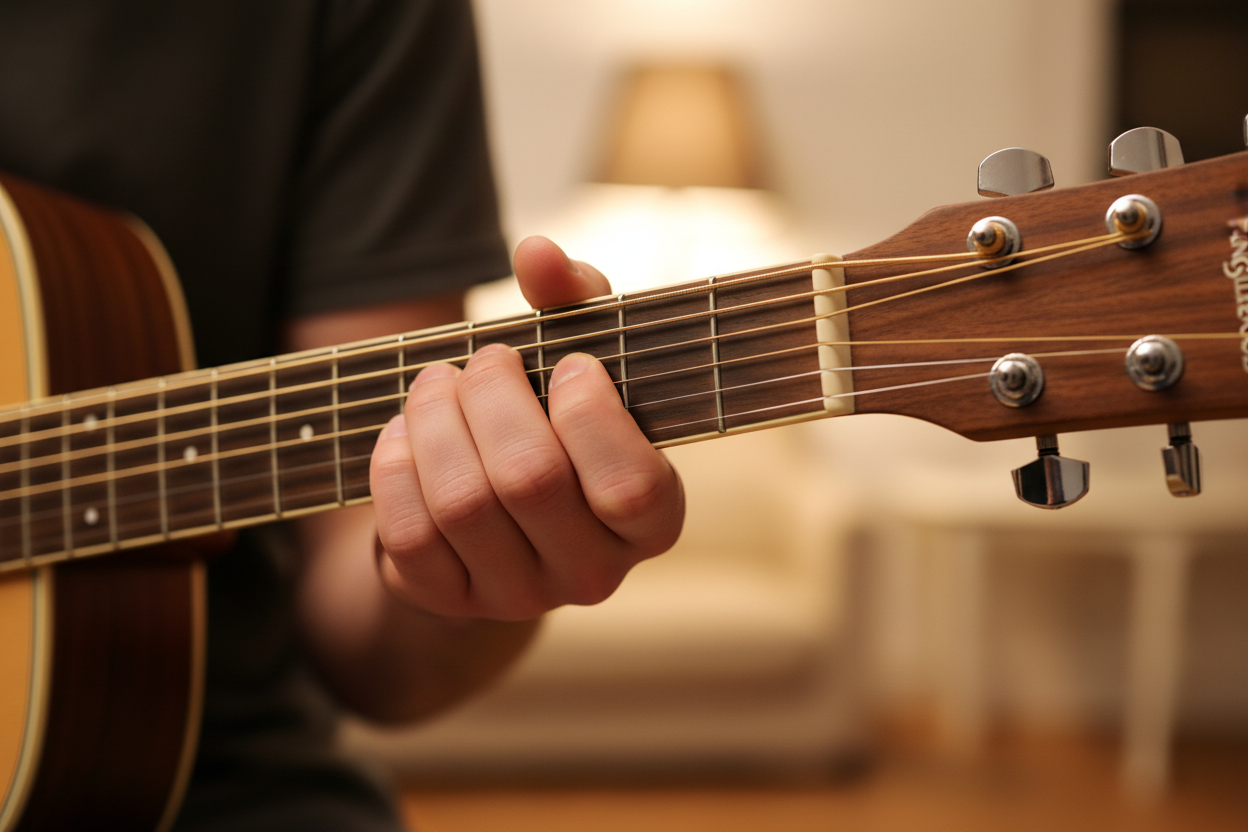Guitar tabs are the secret code many musicians use to play thousands of songs without reading a single note of traditional sheet music. Yet even complete beginners can pick up complicated riffs almost instantly. The real surprise is that guitar tablature translates musical compositions into an intuitive, straightforward format, making it far easier than most people imagine to start creating music from day one.
Table of Contents
- Step 1: Familiarise Yourself With Tab Notation
- Step 2: Identify The Guitar Strings And Frets
- Step 3: Interpret The Tab Lines And Numbers
- Step 4: Practice Playing Simple Tabs
- Step 5: Verify Your Understanding With Complex Tabs
Quick Summary
| Key Point | Explanation |
|---|---|
| 1. Learn to read guitar tabs | Understanding tabs is essential for recognising song structures and techniques without extensive theory knowledge. |
| 2. Familiarise with guitar strings and frets | Knowing string placement and fret positions is key to navigating tabs and producing the correct sounds. |
| 3. Interpret tab lines and numbers carefully | Each line corresponds to a string, and numbers indicate fret positions; correct interpretation is crucial for playing accurately. |
| 4. Practice with simple tabs | Start with easy melodies to build confidence and muscle memory, focusing on accuracy before speed. |
| 5. Progress to complex tabs gradually | Challenge yourself with advanced techniques, ensuring you understand each element before attempting full pieces. |
Step 1: Familiarise Yourself with Tab Notation
Learning how to read guitar tabs is your gateway to understanding musical notation specifically designed for guitarists. Unlike traditional sheet music, guitar tablature provides a visual representation of precisely where and how to play notes on your instrument. Guitar tabs translate musical compositions into an intuitive, straightforward format that allows musicians of all skill levels to quickly comprehend song structures and playing techniques.
At its core, guitar tablature represents the six strings of your guitar as horizontal lines, with each line corresponding to a specific string from bottom (low E) to top (high E). Numbers placed on these lines indicate which fret you should press to produce a particular note. This system eliminates the complexity of traditional musical notation, making it remarkably accessible for beginners and experienced players alike.
To begin understanding tab notation, visualise your guitar neck as a grid. Each horizontal line represents a string, running from the thickest (bottom line) to the thinnest (top line). The numbers positioned on these lines tell you exactly which fret to press.
 A “0” means you play the open string without pressing any fret, while numbers like “3” indicate you should press the third fret on that specific string.
A “0” means you play the open string without pressing any fret, while numbers like “3” indicate you should press the third fret on that specific string.
Reading from left to right, tabs show you the sequence of notes and how they should be played. For instance, if you see “5” on the bottom line (low E string), you know to press the fifth fret on your lowest string. Multiple numbers appearing vertically indicate chords, where you play several notes simultaneously. Some tabs also include additional symbols representing techniques like bends, slides, hammer-ons, and pull-offs, which add nuance to your playing.
Below is a table summarising the most common guitar tab symbols mentioned, along with their meanings and typical usage, providing a quick reference for beginners learning to interpret tablature.
| Symbol | Meaning | Description |
|---|---|---|
| 0 | Open string | Play the string without pressing any fret |
| Number | Fret number | Press the indicated fret on the string |
| b | Bend | Push the string upwards to raise its pitch |
| h | Hammer-on | Play note by hammering-on finger onto the fret |
| p | Pull-off | Play note by pulling-off finger from a fret |
| / | Slide up | Slide finger up the neck to the next note |
| \ | Slide down | Slide finger down the neck to the next note |
As you become more comfortable with tab notation, you’ll discover it provides an incredibly efficient method of learning new songs. According to Guitar World, tabs offer musicians a quick and intuitive way to understand musical compositions without requiring extensive music theory knowledge. Practice reading tabs slowly, ensuring you understand each number’s placement and meaning before attempting to play the full sequence.
Remember, mastering tab reading is a skill that develops with consistent practice. Start with simple, single-note melodies and gradually progress to more complex arrangements. Soon, you’ll find yourself seamlessly translating written tabs into beautiful music on your guitar.
Step 2: Identify the Guitar Strings and Frets
Understanding the guitar’s physical layout is crucial for interpreting tablature accurately. Guitar strings and frets form the fundamental framework of tab notation, creating a precise map for translating musical ideas into playable sounds. Each string represents a different pitch, running from the lowest (thickest) to the highest (thinnest) in a standard tuning configuration.
Your guitar contains six strings, traditionally tuned to the notes E, A, D, G, B, and E (from bottom to top). Starting from the bottom string (low E), the strings progress upwards in pitch. When reading tabs, these strings are represented as horizontal lines, with the bottom line representing the lowest (thickest) string and the top line representing the highest (thinnest) string. This consistent visual representation allows musicians to quickly understand which string and fret to play.
Frets are the metal strips running vertically across your guitar’s neck, dividing it into precise musical intervals. Each fret represents a half-step in musical distance, allowing you to create different notes by pressing the string against these metal markers. When a tab shows a number like “3” on a specific string line, it means you should press that string down just behind the third fret. Open strings (marked with a “0”) are played without pressing any fret, producing the string’s natural, unfretted tone.
To develop muscle memory and familiarity, practice identifying strings and frets without looking at your hands. Start by learning the open string notes, then gradually explore how moving your finger across different frets changes the pitch. If you want to learn more about perfecting your string techniques, understanding string placement is fundamental to your musical journey.
As you become more comfortable, you’ll notice that tablature provides an intuitive visual guide to playing music. The relationship between strings and frets creates a logical system where each number represents a specific sound. According to Guitar World, consistent practice in recognising string and fret positions will dramatically improve your ability to read and play tabs quickly and accurately.
Verify your understanding by attempting to play simple single-note sequences on your guitar, matching the tab notation precisely. Remember, reading tabs is a skill that improves with patience and consistent practice. Each time you successfully translate a number on a string line to an actual note on your guitar, you’re building the foundational skills needed to become a proficient guitarist.

Step 3: Interpret the Tab Lines and Numbers
Interpreting tab lines and numbers transforms written notation into actual musical performance. Tab notation provides a visual roadmap for playing guitar, translating complex musical ideas into straightforward, actionable instructions. Each line represents a guitar string, and the numbers indicate precisely where and how to play each note.
Reading tabs involves understanding directional movement and numeric placement.
Special symbols often accompany numbers to provide additional playing techniques. A “b” indicates a bend, where you physically push the string upward to raise its pitch. Sliding is represented by a diagonal line between numbers, instructing you to smoothly transition between fret positions. Hammer-ons and pull-offs use “h” and “p” respectively, showing more advanced techniques where notes are created through finger movements without re-picking the string.
To develop proficiency, start with simple tab exercises that focus on single-note melodies. Practice reading the numbers slowly, matching each number to the corresponding string and fret. Visualise your finger movements before actually playing, creating a mental connection between the tab notation and physical guitar technique. If you want to understand more about selecting the right guitar strings that complement your playing style, exploring tab notation will help you make more informed choices.
According to Guitar Techniques Magazine, developing tab reading skills requires consistent practice and patience. Start by selecting beginner-friendly tabs with clear, straightforward notation. Pay attention to the rhythm and timing implied by the tab, even though most tabs do not explicitly show note duration.
Verify your understanding by playing through short tab sequences, checking that each number corresponds correctly to your finger placement. Record yourself playing to compare your interpretation with the original tab notation. Remember, reading tabs is a skill that improves with repetition and careful attention to detail. Each successful translation of a tab sequence brings you closer to mastering this essential musical language.
Step 4: Practice Playing Simple Tabs
Practicing simple tabs is the critical bridge between understanding tablature notation and actually creating music on your guitar. Developing muscle memory and confidence requires systematic, patient practice that transforms theoretical knowledge into practical skill. Begin with extremely straightforward, single-note melodies that allow you to focus on precise finger placement and tab interpretation.
Select beginner-friendly tabs that use minimal strings and straightforward techniques. Look for single-string melodies or basic riffs with clear, uncomplicated notation. Popular nursery rhymes, simple folk tunes, or recognisable movie themes often provide excellent starting points for new tab readers. Pay close attention to each number’s placement, ensuring your finger lands exactly on the specified fret for each note.
When practicing, break down the tab into small, manageable segments. Start by playing each note slowly and deliberately, prioritising accuracy over speed. Use a metronome or slow practice technique to maintain consistent timing, gradually increasing your pace as you become more comfortable. Listen carefully to each note, confirming that the sound matches what you expect based on the tab notation. If a note sounds incorrect, return to the tab and double-check your finger placement.
To enhance your learning experience, explore our collection of easy guitar songs for beginners, which can provide additional context and practical examples for tab reading. These resources can offer structured progressions that complement your learning journey.
According to Guitar World, developing tab reading skills requires consistent, focused practice. Create a routine where you dedicate 15-20 minutes daily to working through simple tabs. Record yourself playing to objectively assess your progress, listening for precision in note selection and clean transitions between frets.
Verification of your tab reading skills involves several key indicators. Can you play a simple tab from start to finish without frequent mistakes? Do you understand the relationship between the numbers and actual string/fret positions? Are you able to maintain a steady rhythm while reading the tab? These benchmarks demonstrate your growing proficiency.
The following table provides a concise checklist to help you verify your tab reading and playing skills as you transition from simple to complex arrangements.
| Verification Step | Completion Indicator |
|---|---|
| Play simple tabs from start to finish without mistakes | Consistent, error-free performance |
| Correctly match numbers to strings and frets | Accurate finger placement |
| Maintain steady rhythm while reading the tab | Consistent timing throughout the piece |
| Interpret chords and symbols in complex tabs | Successful use of advanced techniques |
| Record and self-assess playing | Identify progress and areas for improvement |
Remember that learning to read tabs is a gradual process. Some days will feel more challenging than others, but consistent practice transforms complexity into intuitive understanding. Celebrate small victories, be patient with yourself, and enjoy the journey of translating written notation into beautiful music.
Step 5: Verify Your Understanding with Complex Tabs
Progressing from simple to complex tabs represents a significant milestone in your guitar learning journey. Complex tablature challenges your technical understanding and pushes your musical interpretation skills to new heights. These advanced tabs incorporate multiple playing techniques, intricate note sequences, and more sophisticated musical arrangements that test your newfound tablature reading abilities.
Begin by selecting tabs that introduce more advanced techniques like bends, hammer-ons, pull-offs, and sliding. Look for tabs that combine vertical chord notations with horizontal melodic lines, which require simultaneous coordination of different strings and techniques. These complex notations demand increased concentration and precise finger movements, transforming your understanding from basic reading to nuanced musical performance.
When approaching complex tabs, develop a systematic deconstruction strategy. Break down the tab into smaller, manageable sections, studying each technique individually before attempting to play the entire piece. Pay special attention to symbols and notations indicating advanced techniques. A bend (“b”) might require you to push the string upward, while a slide (“/” or "") instructs smooth movement between fret positions. Practice these individual techniques slowly, focusing on accuracy before attempting full-speed execution.
To support your learning progression, explore our guide on mastering guitar skills, which can provide additional context and advanced playing techniques. Understanding the broader context of musical performance will enhance your tab reading capabilities.
According to Guitar Techniques Magazine, developing proficiency with complex tabs requires patience and strategic practice. Create a practice routine that gradually increases complexity, allowing your muscle memory and visual interpretation skills to develop naturally. Record yourself playing these more challenging tabs, comparing your performance against professional recordings to identify areas for improvement.
Verification of your complex tab reading skills involves several key assessments. Can you successfully play tabs with multiple simultaneous techniques? Do you understand the nuanced symbols and notations beyond basic fret numbers? Are you able to maintain musical timing and rhythm while executing complex finger movements? These benchmarks demonstrate your advanced tablature comprehension.
Remember that mastering complex tabs is a continuous learning process. Some techniques might feel challenging initially, but consistent practice transforms complexity into fluid musical expression. Embrace the difficulty, celebrate incremental improvements, and remain patient with your musical development. Each challenging tab you successfully navigate brings you closer to becoming a proficient guitarist.
Ready to Turn Your Tab Skills Into Real Music?
You have just learned how to read guitar tabs and how tab notation can help you master new songs with ease. Yet, many players find their progress stalls when they cannot access quality instruments or the right guidance. Are you searching for a guitar or gear that will let you put your new tab reading skills into action? Maybe you want advice or support that makes the transition from learning to playing smooth and inspiring.

Now is the perfect moment to take the next step. Visit MusicStreet.co.uk to explore our curated selection of premium guitars, expert advice, and educational resources designed for players just like you. Whether you are seeking your first instrument, reliable accessories, or in-person help from our experienced team in Huntingdon, we support every step of your musical journey. For more guidance on perfecting your technique, discover our Ultimate Guide to Mastering Your Guitar Skills or start browsing our latest easy guitar songs for beginners and play your first full tune today. Make your practice meaningful by partnering with a trusted source that puts musicians first.
Frequently Asked Questions
How do I start reading guitar tabs as a beginner?
To start reading guitar tabs as a beginner, familiarise yourself with the layout of guitar strings represented by horizontal lines. Begin by practicing with simple, single-note melodies, and focus on identifying the numbers indicating the frets to be pressed. Try to read a few easy tabs daily to build confidence and understanding.
What do the numbers on guitar tabs mean?
The numbers on guitar tabs indicate which fret you should press on a specific string to produce a note. For example, if you see a ‘3’ on the second line up from the bottom, press the third fret on that string. Start by practicing with short sequences to solidify your grasp of fret positioning.
How can I practice guitar tabs effectively?
To practice guitar tabs effectively, break the tab down into manageable sections and play each note slowly, ensuring accuracy before increasing speed. Use a metronome to help maintain a steady rhythm, and aim for at least 15-20 minutes of focused practice each day. This structured approach helps build your muscle memory over time.
What are common guitar tab symbols I should know?
Common guitar tab symbols include ‘b’ for bends, ‘h’ for hammer-ons, ‘p’ for pull-offs, and ‘/’ or '' for slides. Familiarise yourself with these symbols as they indicate specific techniques to enhance your playing. Begin by learning one or two symbols at a time, incorporating them into your practice sessions to develop a more nuanced playing style.
How do I progress from simple to complex guitar tabs?
To progress from simple to complex guitar tabs, gradually introduce tabs that include additional techniques and multiple strings. Start by mastering simple single-note melodies and then move on to tabs that incorporate chords or advanced symbols. This progression will challenge your skills and help you become more proficient over time.
How can I verify my understanding of guitar tabs?
To verify your understanding of guitar tabs, attempt to play simple tabs from start to finish without frequent mistakes. Record yourself and listen back to assess your accuracy in note selection and timing. Regularly practising and self-evaluating will ensure you are effectively translating tab notation into music.




Share:
Understanding Why Boutique Amps Matter for Musicians
Why the Yamaha Pacifica 112V is the UK's Best-Selling Beginner Guitar – 2025 Comparison